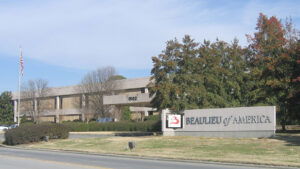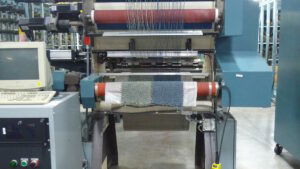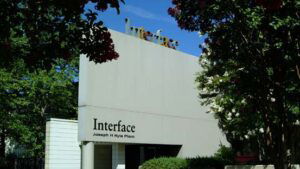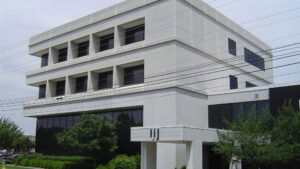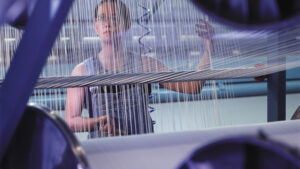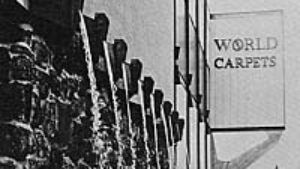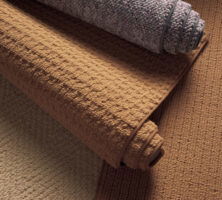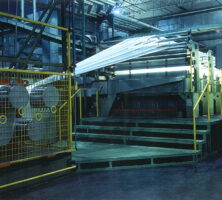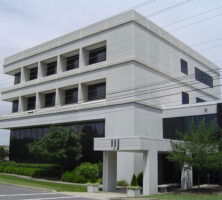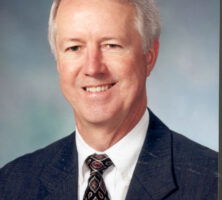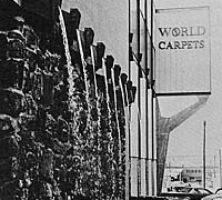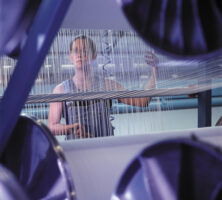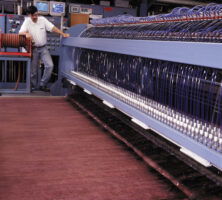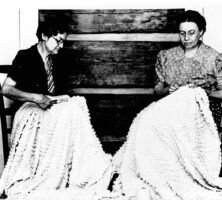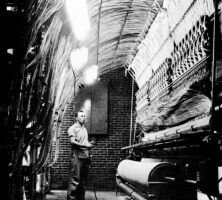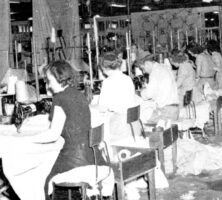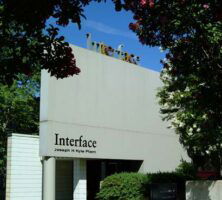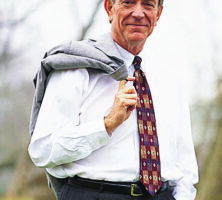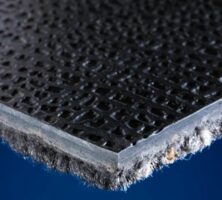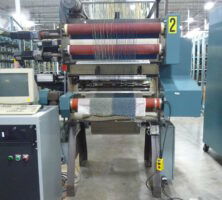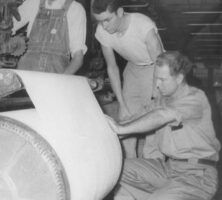The New Georgia Encyclopedia is supported by funding from A More Perfect Union, a special initiative of the National Endowment for the Humanities.
The corporate offices of Beaulieu of America, once one of the nation's largest tufted-carpet manufacturers, were located in Dalton. The company was founded in 1978 by Belgian immigrant Carl Bouckaert.
Courtesy of Beaulieu Group LLC
The New Georgia Encyclopedia does not hold the copyright for this media resource and can neither grant nor deny permission to republish or reproduce the image online or in print. All requests for permission to publish or reproduce the resource must be submitted to the rights holder.
Beaulieu of America manufactured a variety of commercial carpet styles under the brand names Cambridge, Bolyu, and Aqua. The company also manufactured and sold polypropylene berber yarns, which it first developed around 1982.
Courtesy of Beaulieu Group LLC
The New Georgia Encyclopedia does not hold the copyright for this media resource and can neither grant nor deny permission to republish or reproduce the image online or in print. All requests for permission to publish or reproduce the resource must be submitted to the rights holder.
A piece of machinery known as a "drawline" stretches carpet at Beaulieu of America's Marglen facility in Rome. Beaulieu manufactured carpet from recycled plastic at Marglen.
Courtesy of Beaulieu Group LLC
The New Georgia Encyclopedia does not hold the copyright for this media resource and can neither grant nor deny permission to republish or reproduce the image online or in print. All requests for permission to publish or reproduce the resource must be submitted to the rights holder.
The offices of J & J Industries, one of the largest carpet manufacturers in the industry, are located in Dalton. Founded in 1957, the company specializes today in the manufacture and sale of commercial carpet.
Courtesy of Thomas M. Deaton
The New Georgia Encyclopedia does not hold the copyright for this media resource and can neither grant nor deny permission to republish or reproduce the image online or in print. All requests for permission to publish or reproduce the resource must be submitted to the rights holder.
Jim Jolly, son of J & J Industries' cofounder Rollins Jolly, joined the company in 1967, three years after graduating from the Georgia Institute of Technology. In 2002 he received the Joseph J. Smrekar Memorial Award, given in recognition of outstanding contributions to the carpet and rug industry.
Courtesy of Thomas M. Deaton
The New Georgia Encyclopedia does not hold the copyright for this media resource and can neither grant nor deny permission to republish or reproduce the image online or in print. All requests for permission to publish or reproduce the resource must be submitted to the rights holder.
The New Georgia Encyclopedia does not hold the copyright for this media resource and can neither grant nor deny permission to republish or reproduce the image online or in print. All requests for permission to publish or reproduce the resource must be submitted to the rights holder.
The New Georgia Encyclopedia does not hold the copyright for this media resource and can neither grant nor deny permission to republish or reproduce the image online or in print. All requests for permission to publish or reproduce the resource must be submitted to the rights holder.
The headquarters of World Carpets, pictured in 1969, featured a waterfall on its Morris Street side. World Carpets was founded in Dalton in 1954 by husband and wife Shaheen Shaheen and Piera Barbaglia.
From World Carpets: The First Thirty Years, by S. Shaheen
The New Georgia Encyclopedia does not hold the copyright for this media resource and can neither grant nor deny permission to republish or reproduce the image online or in print. All requests for permission to publish or reproduce the resource must be submitted to the rights holder.
In beam carpet tufting operations, strands from approximately twelve large beams of yarn are guided into the needles of a tufting machine.
Courtesy of Shaw Industries, Inc.
The New Georgia Encyclopedia does not hold the copyright for this media resource and can neither grant nor deny permission to republish or reproduce the image online or in print. All requests for permission to publish or reproduce the resource must be submitted to the rights holder.
Continuous dyeing operations, which apply dye after the carpet is tufted instead of before, provide virtually limitless color options. Here, on Shaw Industries' multicolor line, different shades of color are applied simultaneously to give the carpet a soft, layered effect.
Courtesy of Shaw Industries, Inc.
The New Georgia Encyclopedia does not hold the copyright for this media resource and can neither grant nor deny permission to republish or reproduce the image online or in print. All requests for permission to publish or reproduce the resource must be submitted to the rights holder.
Two ladies hand tufting spreads. By World War I, women all over north Georgia were tufting bedspreads in their homes for local spread houses (run mostly by women), who paid from a nickel to $2.50 a spread, depending upon the complexity of the pattern.
Courtesy of Shaw Industries, Inc.
The New Georgia Encyclopedia does not hold the copyright for this media resource and can neither grant nor deny permission to republish or reproduce the image online or in print. All requests for permission to publish or reproduce the resource must be submitted to the rights holder.
The New Georgia Encyclopedia does not hold the copyright for this media resource and can neither grant nor deny permission to republish or reproduce the image online or in print. All requests for permission to publish or reproduce the resource must be submitted to the rights holder.
An early twelve-foot-wide tufting machine in operation at Shaw Industries, circa 1964. In this photo, yarn is fed through tubes at high speeds from cone positions at the left. First invented in the early 1950s, these machines allowed tufted carpets to compete successfully against woven carpets. By 1965 more than 85 percent of broadloom carpeting sold in the United States was tufted.
Courtesy of Shaw Industries, Inc.
The New Georgia Encyclopedia does not hold the copyright for this media resource and can neither grant nor deny permission to republish or reproduce the image online or in print. All requests for permission to publish or reproduce the resource must be submitted to the rights holder.
The New Georgia Encyclopedia does not hold the copyright for this media resource and can neither grant nor deny permission to republish or reproduce the image online or in print. All requests for permission to publish or reproduce the resource must be submitted to the rights holder.
To increase productivity at Shaw Industries in the late 1940s, sewing machines were grouped together and hooked to an electric or steam-powered line shaft.
Courtesy of Shaw Industries, Inc.
The New Georgia Encyclopedia does not hold the copyright for this media resource and can neither grant nor deny permission to republish or reproduce the image online or in print. All requests for permission to publish or reproduce the resource must be submitted to the rights holder.
The Interface plant at LaGrange is the company's original site. Interface now has plants in five other states (California, Maine, Michigan, New York, and North Carolina) and two other countries (Australia and England).
Courtesy of Interface
The New Georgia Encyclopedia does not hold the copyright for this media resource and can neither grant nor deny permission to republish or reproduce the image online or in print. All requests for permission to publish or reproduce the resource must be submitted to the rights holder.
Ray Anderson is the founder and chairman of the board at Interface, the world's largest manufacturer of commercial carpeting.
Courtesy of Interface
The New Georgia Encyclopedia does not hold the copyright for this media resource and can neither grant nor deny permission to republish or reproduce the image online or in print. All requests for permission to publish or reproduce the resource must be submitted to the rights holder.
Interface's high-recycled-content carpet backing, GlasBac. Interface has been an industry leader in the manufacturing of recyclable products and the reduction of emissions from carpet plants.
Courtesy of Interface
The New Georgia Encyclopedia does not hold the copyright for this media resource and can neither grant nor deny permission to republish or reproduce the image online or in print. All requests for permission to publish or reproduce the resource must be submitted to the rights holder.
The carpet industry remains heavily concentrated in Georgia in the twenty-first century. Of the industry's $11 billion in wholesale sales in 1997, Georgia establishments accounted for more than $8 billion, and 32,000 of the industry's 50,000 workers toiled in Georgia mills.
Photograph by Charles & Hudson
The New Georgia Encyclopedia does not hold the copyright for this media resource and can neither grant nor deny permission to republish or reproduce the image online or in print. All requests for permission to publish or reproduce the resource must be submitted to the rights holder.
Wokers for the Thomaston Mills in Upson County inspect a roll of cotton fabric. During the 1950s, inexpensive tufted cotton carpets began to replace higher-quality wool carpets in the marketplace.
Courtesy of Thomaston-Upson Archives
The New Georgia Encyclopedia does not hold the copyright for this media resource and can neither grant nor deny permission to republish or reproduce the image online or in print. All requests for permission to publish or reproduce the resource must be submitted to the rights holder.
The New Georgia Encyclopedia does not hold the copyright for this media resource and can neither grant nor deny permission to republish or reproduce the image online or in print. All requests for permission to publish or reproduce the resource must be submitted to the rights holder.
The New Georgia Encyclopedia does not hold the copyright for this media resource and can neither grant nor deny permission to republish or reproduce the image online or in print. All requests for permission to publish or reproduce the resource must be submitted to the rights holder.
The New Georgia Encyclopedia does not hold the copyright for this media resource and can neither grant nor deny permission to republish or reproduce the image online or in print. All requests for permission to publish or reproduce the resource must be submitted to the rights holder.
